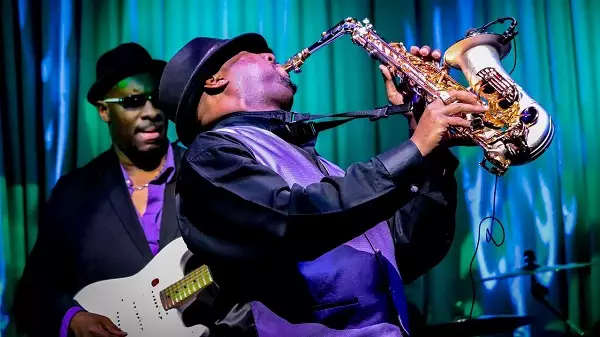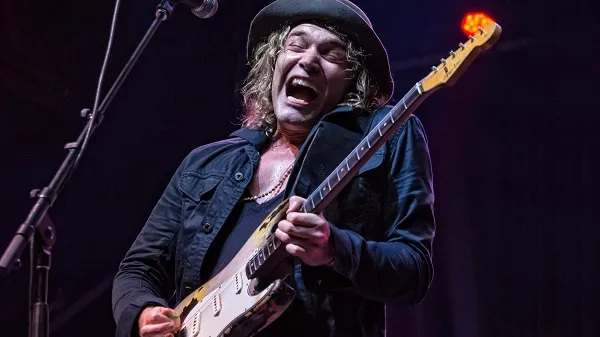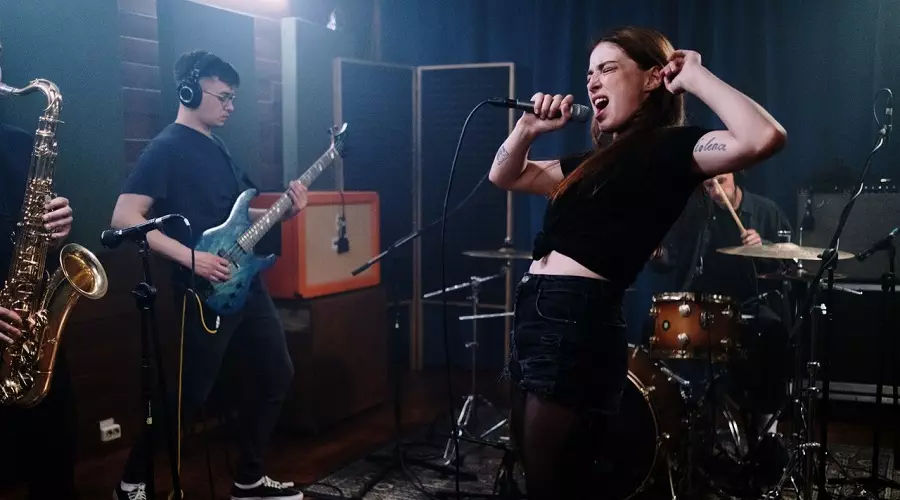When I was younger, I used to think blues music was all about sadness and depression. After all, that’s one of the meanings of the word ‘blue’ in English.
It wasn’t until I started listening to this genre that I discovered I was way off.
Sure, blues music does evoke such feelings of sorrow and despair, but it can also bring forward an array of emotions like hope, joy, and relaxation.
Throughout its rich history, the blues has touched people in every situation and stage of life, continuing to leave its mark until this day.
Below is a list of all the types of blues music, which gives you a glimpse of just how deep and harmonic this genre is.
1. Acoustic Blues
Acoustic Blues encompasses just about every type of blues that you can play on a non-electric musical instrument. This includes a wide range of guitar and musical styles such as folk, slide, fingerpicking, and all the regional strains (Chicago, Delta, Louisiana, Mississippi, and so on.)
Acoustic blues isn’t limited to guitar music, but it expands much further to include mandolin, piano, banjo, harmonica, and more. John Lee Hooker and Memphis Slim are among the top artists of this music.
2. African Blues
A genre of popular music, African blues originated in West Africa. Ali Farka Touré, the Malian guitar legend, was a pioneer of African desert blues and one of the continent’s most internationally renowned musicians.
His death in 2006 sparked a new round of speculation regarding the roots of the blues in Africa. Touré famously claimed that blues music was “nothing but African”.
3. Blues Rock
Blues rock is a fusion genre featuring elements of blues and rock music. Primarily an electric style of music, blues rock involves instruments like the electric guitar, electric bass guitar, and drums.
Major artists of the blues rock scene include Cream and the Paul Butterfield Blues Band.
4. Blues Shouter
A blues shouter is a blues singer who can sing unamplified with a band. They’ll belt out songs at constant full volume, performing in a way that projects energy and drives the audience to get on their feet due to the electricity in the air.
5. Boogies-Woogie Blues
This type of blues got popular during the late 1920s but it first originated in African-American communities in the 1870s. The Boogies-Woogie piano style evolved from the “stride piano” of the early 1900s and became a national trend during the war years and after.
Some of the best Boogie-Woogie artists include Clarence “Pine Top” Smith, Pinetop Perkins, and Big Joe Turner.
6. British Blues
British blues is a style of blues music derived from the American genre. It originated in the late 1950s and peaked in the 1960s. The guitarist, Alexis Korner, is often referred to as the founding father of British blues.
7. Canadian Blues
Canadian blues is the blues and music associated with the blues performed by blues singers and bands in Canada. Although the country was introduced to this genre decades earlier, the blues wasn’t popular among Canadian performers until the early 1960s.
8. Chicago Blues
This form of blues music was developed in Chicago, Illinois. It’s based on blending the sound of the electric guitar and the harmonica, both heavily amplified – often to the point of distortion. A rhythm section of drums and bass with piano may also be incorporated depending on the song or performer.
Described as delta blues amplified, artists like Muddy Waters, Buddy Guy, Magic Sam, and Otis Rush are among its all-time top musicians.
9. Classic Blues
Classic blues refers to the oldest styles of blues that originated in the southeastern United States in the late 1800s. This term points to a family of styles including country blues and delta blues.
10. Classic Female Blues
Popular in the 1920s, classic female blues is an early form of blues music that’s also known as Vaudeville blues. This style is a mixture of traditional folk blues and urban theater, performed by female singers and pianists or small jazz groups.
Classic female blues first surfaced in 1902 when Ma Rainey started incorporating blues songs into her vaudeville routines. Considered as the first blues music to be recorded, famous singers in this genre include Ma Rainey, Bessie Smith, and Ethel Waters.
11. Contemporary Blues
Contemporary blues combines characteristics of traditional acoustic and electric blues, but with elements of rock, pop, R&B, and/or folk thrown into the equation. As a result, contemporary blues is mostly electric and rarely purist.
This style is more polished and mellow, yet still packs a lot of ‘soul’. It lacks the rawness of the older blues and dials down the fierceness of modern-day electric blues from Chicago or Texas.
Influential artists of contemporary blues include Robert Cray, Keb’ Mo’, Kenny Wayne Shepherd, and Jonny Lang.
12. Contemporary R&B
Contemporary R&B combines rhythm and blues along with influences of soul, pop, hip hop, funk, and electronic music. It emerged years after urban R&B, but it shares the same slick production aspect.
Many artists like Maxwell, Bruno Mars, John Legend, and D’Angelo managed to bring back the grit and spirit of the classic soul to contemporary R&B.
13. Country Blues
Country blues got its name as a distinguishment for traditional rural blues from urban styles that that developed later on. This genre reflects the everyday dreams and struggles of common working people.
It first came about in the 1920s and 1930s in the deep south of the Mississippi Delta, but it has deep roots in African American culture and songs sung by slaves in older times.
Fundamentally, country blues music is just a human voice accompanied by an instrument like a guitar or harmonica. There are no electric instruments involved, making this genre completely acoustic.
Most country blues artists were African American and itinerant. This means they traveled across different regions of the American South, singing in places like churches, social halls, and street corners.
14. Delta Blues
One of the earliest recognized forms of blues, delta blues originated in the Mississippi Delta. It’s considered a regional variant of country blues where a solo performs sings while playing a guitar or harmonica.
15. Detroit Blues
Detroit blues isn’t as historically celebrated as other types of blues because:
- The city is better known for jazz, gospel, Motown, and hard-driving rock & roll music.
- Its Midwestern neighbor Chicago has shone much brighter in the blues scene.
That being said, John Lee Hooker is probably the only performer to get famous directly through the Detroit blue. Unfortunately, his style was difficult to imitate, so it never became the standard form of the city.
16. Electric Blues
Any type of blues music that involved the use of electric amplification for musical instruments falls under the category of electric blues. Used by T-Bone Walker in the late 1930s and John Lee Hooker and Muddy Waters in the 1940s, the guitar was the first instrument to be widely amplified.
17. Gospel Blues
This style of blues has been around since the birth of blues music, combining evangelistic lyrics with blues instrumentation. Renowned gospel blues performers include Blind Willie Johnson and Sister Rosetta Tharpe.
18. Hill Country Blues
Also known as North Mississippi hill country blues and North Mississippi blues, hill country blues is distinguished by a heavy emphasis on unconventional song structures, few chord changes, rhythm and percussion, steady guitar riffs, and strong stressing on the “groove” – which has been referred to as the “hypnotic boogie”.
Notable artists of hill country blues include R. L. Burnside, Junior Kimbrough, Mississippi Fred McDowell, and Jessie Mae Hemphill.
19. Hokum Blues
Hokum is a song type of American blues music in which a humorous song uses analogies or euphemistic terms to make sexual innuendos. Some of the hokum blues records sold hundreds of thousands of copies contained quite explicit lyrics referring to sexual practices, prostitution, and homosexuality.
This ‘Hokum’ craze peaked throughout the sizzling atmosphere of the ‘Prohibition’ era in the late 1920s and early 1930s.
20. Jump Blues
Jump blues is a combination of swing, blues, and boogie-woogie music that resulted in the creation of an up-beat type of blues. Typically, it was played by small groups accompanied by horn instruments.
Jump blues reached its all-time popularity in the 1940s and served as the precursor of R&B and rock&roll.
21. Louisiana Blues
A regional descendant of country blues, Louisiana blues is a genre of blues music that emerged after World War II in the state of Louisiana.
It’s divided into two main subgenres: the jazz-influenced New Orleans blues (influenced by the musical traditions of that city) and the slower tempo swamp blues (which incorporates elements from zydeco and Cajun music from Baton Rouge).
Great artists of Louisiana blues include Slim Harpo, Lightnin’ Slim, Lazy Lester, and Professor Longhair.
22. Memphis Blues
A short-lived type of blues, Memphis blues was developed from the 1910s to the 1930s by musicians in the Memphis area such as Frank Stokes, Sleepy John Estes, and Furry Lewis.
23. New Orleans Blues
This is a subgenre of blues that originated from the city of New Orleans. Heavily influenced by jazz and Caribbean music, New Orleans blues is dominated by piano and saxophone.
Significant figures in this genre include Professor Longhair, Guitar Slim, Fats Domino, Dr. John, and Allen Toussaint.31.
24. Piedmont Blues
Also known as East Coast, or Southeastern blues, the Piedmont blues was got its name from the Piedmont plateau region. This type of blues music refers to a guitar style that’s characterized by a fingerpicking approach.
The sound of Piedmont blues is comparable to that of ragtime or stride piano styles. In fact, it’s differentiated from the Mississippi Delta blues by its ragtime-based rhythms.
Major artists of Piedmonts blues include Blind Boy Fuller, Reverend Gary Davis, Sonny Terry, and Blind Blake.
25. Punk Blues
Punk blues is a music genre that incorporates elements of both punk rock and blues. The resulting mix emphasizes the shared rawness, simplicity, and emotion between the punk and blues genres.
The Jon Spencer Blues Explosion, The Gun Club, The White Stripes, and Oblivians are among the most popular bands of punk blues.
26. Rhythm and Blues
Commonly known as R&B or RnB, rhythm and blues is a popular genre of music that emerged in the 1940s in African-American communities. Originally, record companies used the ‘rhythm and blues’ to market urban African American music.
Famous artists of this genre include Beyoncé, Chris Brown, and Drake.
27. Soul Blues
A fusion of soul and blues music, soul blues originated in the late 1960s and early 1970s. Renowned artists of this type of blues include B.B. King and Bobby Bland.
28. Swamp Blues
Swamp blues is a variant of Louisiana blues that originated in the 1950s and 1960s around Baton Rouge. Compared to country blues, it’s more rhythmic with a laid-back, slow tempo that’s influenced by New Orleans blues, zydeco, and soul music.
Artists like Lazy Lester, Slim Harpo, Lightnin’ Slim, and Lonesome Sundown are among the greatest of this genre.
29. Texas Blues
As the name suggests, Texas blues is blues music that originated from Texas. This regional style was initially characterized by jazz and swing influences, but it later developed to become closer to the sound of blues rock and Southern rock.
Texas blues first started to appear in the early 1900s among African Americans who worked in oilfields. Artists who contributed to the popularity of Texas blues include Stevie Ray Vaughan, Lightnin’ Hopkins, T‑Bone Walker, and Freddie King.
30. Zydeco Blues
Zydeco is a music genre that originated in southwest Louisiana by French Creole speakers. It combines blues, rhythm and blues, and music indigenous to the Louisiana Creoles as well as the Native American people of Louisiana.
Although the history of the name is debatable, many believe that it’s derived from the French phrase “Les haricots ne sont pas salés”, which translates idiomatically as “times are hard”.
Buckwheat Zydeco, Clifton Chenier, Boozoo Chavis, and Geno Delafose are among the notable artists of this genre.












